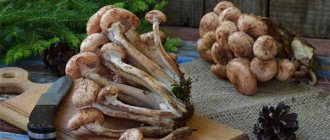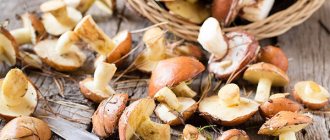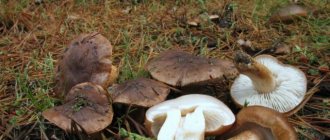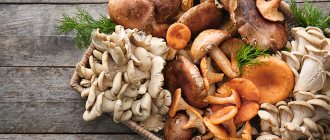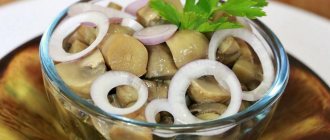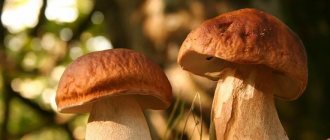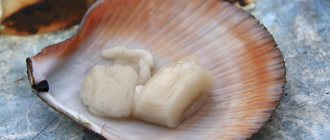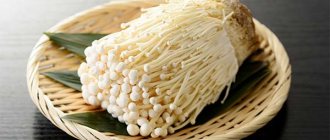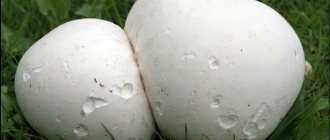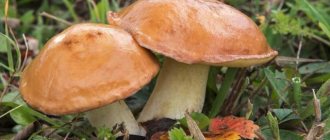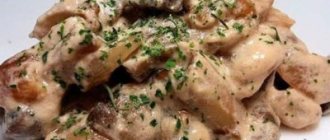© Andrii — stock.adobe.com
Share:
Oyster mushrooms are tasty and nutritious mushrooms widely used in cooking. They can be boiled, fried, pickled, salted, without losing their nutritional and beneficial properties. Unlike its forest counterparts, this product is available at any time of the year.
The benefits of oyster mushrooms for the body lie in their composition, rich in vitamins and microelements. The presence of useful substances helps strengthen the immune system and prevent various diseases. Eating mushrooms provides the body with biologically active substances and amino acids. The product has no toxic effects. Oyster mushroom is completely edible and safe.
What do oyster mushrooms look like and where do they grow?
All Pleurotus species (except one) grow on trees, which is why they got their name. They can mainly be found on birch, aspen, willow and pine trees. They do not cause any damage to trees because they begin to grow on stumps or diseased plants. In nature, harvesting occurs from spring to autumn, depending on the species.
They are also easy to grow on substrates, which is why you can most often find an artificially grown product on store shelves. They are cultivated on sawdust, paper, shavings. Growing temperature and humidity do not matter. Therefore, crops can be harvested 365 days a year.
Externally, the variety differs from others in that the cap, reaching a diameter of 5–20 cm, turns into a tubular 5-centimeter stem. Mushrooms grow in large groups, which is why you can often see several caps on one fruiting body. The weight of one group can reach 1–3 kg. There are several types of oyster mushroom, most of them are edible, but there are also poisonous representatives of spore mushrooms. Depending on the subspecies, the color of mushrooms can vary from white to brown-violet.
Kinds
The types of oyster mushrooms depend on the tree on which they grow. The most famous are the following:
- Ordinary.
The most common type. It grows on the trunks of deciduous trees and can be found from June to October. But in early frosts the mushrooms freeze. The gray or brown oyster cap grows up to 20 cm; there can be about 40 pieces in a group. - Horn-shaped.
It has a distinctive white funnel-shaped cap. When cut from a tree, the mushroom darkens to brown within a few hours. It grows on maple and elm trunks exclusively in summer. In Japan, growing the variety on fallen elms is widespread. - Pulmonary.
It looks like a white horn-shaped one, but the cap is flat and elongated. Young small fruits have a special taste; as they grow, they become tougher. - Gray.
Grows in the USA and Europe on coniferous trees. Gray color is acquired due to lack of light and high humidity. - Pink.
Rarely found in nature in the tropics. A distinctive feature is that the cap is located on the side of the stem. You can artificially achieve the characteristic coral color by growing mushrooms on corn cuttings, as well as crushed dried cotton bolls and stems. The temperature required for fruit growth is above 30°C. - Ilmak mushroom (lemon-cap mushroom).
The most beautiful and unusual variety. Its bright yellow cap has a pungent odor, and dishes made from it acquire a nutty flavor. It grows on the elm (elm) tree and bears fruit longer than other species from mid-spring to late autumn. - Steppe.
It is also called royal and the most delicious among other species. Specimens with a gray-red color have the best taste. As it becomes discolored with age, the mushroom loses its flavor and becomes bitter. Has a thick fleshy leg. This is the only species that grows on soil.
What you should know about oyster mushroom
Origin
Oyster mushrooms are a real health remedy and also have an excellent taste. They are native to Southeast Asia, where they sprout on tree trunks and rotten wood before the first night frosts in the fall and winter.
Oyster mushrooms sold in stores are cultivated mushrooms and are therefore available year-round. Breeders from different countries specialize in oyster mushrooms and grow them in huge rooms, usually on bales of chopped wet straw. This sounds simple, but requires a lot of effort because young mushroom shoots are sensitive to microbes or spores from other fungi. Therefore, producers pay attention to the highest level of hygiene and absolute sterility, so as not to endanger the harvest.
How to grow oyster mushrooms
Oyster mushrooms are popular edible mushrooms and are grown in large quantities. The main substrate is wood and straw, but other agricultural waste and by-products can also be used for cultivation.
When grown indoors, abundantly released spores can lead to health problems, since they can cause allergic reactions when inhaled.
On an industrial scale, oyster mushrooms are usually grown on wheat straw. Wheat straw is sterilized and well moistened with water. Then spores or old pureed oyster mushrooms are added to the straw. Over the next few weeks, the mushroom mycelium grows through the straw until the fruiting bodies grow. If all conditions are met, you can collect about 20 kg of mushrooms per square meter of cultivated area.
Storage
Immediately after harvesting, oyster mushrooms are cleared of straw residues directly on site, packaged and transported to the store at a temperature not exceeding 3 °C. Mushrooms should be stored there at the same temperature. If these conditions are met, they can remain fresh for about 8 days.
Oyster mushrooms should be used as soon as possible after purchase. It is advisable to wrap these mushrooms in a paper towel and store them in the vegetable compartment of the refrigerator for no more than one or two days.
Composition and calorie content
The chemical composition of oyster mushrooms is saturated with a valuable vitamin complex, which includes the following vitamins:
- A - has a beneficial effect on the organ of vision, and also promotes rapid healing of the mucous membrane and bones.
- B – the whole complex – promotes the regeneration of blood cells, which is necessary during the rehabilitation period after surgery. Improves the condition of skin and hair.
- D – forms bone tissue, improves the nervous system, improves good mood. It is indispensable for athletes because it strengthens muscle tissue.
- PP – cleanses the blood of cholesterol.
- Betaine is necessary for diseases of the stomach and intestinal tract.
The entire set of vitamins strengthens bones and muscles, improves the functioning of brain activity and the entire body as a whole.
In addition to vitamins, the product is rich in microelements such as magnesium, calcium, zinc, fluorine, sodium and phosphorus.
The energy value is as follows:
- 100 g of mushrooms contain 35 calories.
- Fats – 0.41 g.
- Proteins – 3.31 g.
- Carbohydrates – 3.79 g.
We recommend reading:
composition and calorie content of shiitake mushrooms
Read
What are oyster mushrooms made of?
The caps of these mushrooms can be of different colors: yellow, pink, brown, gray. The color depends on the place where they grow. Usually only the caps are eaten; the legs of oyster mushrooms are very tough. In terms of nutritional value, these mushrooms can be compared with champignons and porcini mushrooms.
The composition of oyster mushrooms is unique ; they contain vitamins, acids, fats and carbohydrates. In addition, raw mushrooms are low in calories. These mushrooms contain vitamin PP, which is rarely found in mushrooms. They contain ten of the twenty amino acids that are necessary for humans. Due to their high protein content, these mushrooms can be compared to meat products.
It also contains a large number of minerals : iron, zinc, selenium, calcium, etc. All the beneficial substances contained in oyster mushrooms are necessary for humans for the proper and healthy functioning of organs and systems.
What are the benefits of oyster mushrooms?
These mushrooms are similar to meat and dairy products in composition and the presence of excess vitamin D and protein. These substances help build and restore muscle mass and bones. In addition, oyster mushrooms:
- speed up metabolism;
- break down cholesterol and thin the blood;
- reduce the risk of allergic reactions;
- remove toxins;
- stop cell mutation, which prevents the occurrence of cancer.
For women
- Oyster mushrooms are rich in folic acid, which is part of the chemical composition. It helps in the treatment and prevention of gynecological diseases.
- Have a beneficial effect on the condition of the skin and hair.
- Promote rapid recovery during the postpartum period.
- Helps in the treatment of mastopathy.
- They improve the digestive process and speed up metabolism, helping to quickly lose weight without gaining it back.
- Have a beneficial effect on the functioning of the thyroid gland.
For men
- Restore the vital activity of sperm.
- Treat male infertility.
- They help with sports and promote rapid muscle mass gain.
During pregnancy
During this period, the use of oyster mushrooms must be treated with caution. Due to their ability to absorb harmful substances from the environment, mushrooms collected near the highway are especially dangerous. During this period, it is better to give preference to mushrooms grown artificially. If there is no doubt about the quality of the purchased product, then it is possible and even necessary to eat them in moderation.
- Nicotinic acid promotes fetal development and normalizes blood circulation.
- Lecithin regulates the heart function of not only women, but also children.
- Due to their high nutritional value, mushrooms saturate the body, relieve hunger and prevent you from gaining excess weight.
During pregnancy, you should avoid salted and pickled mushrooms. They can not only cause heartburn and increase toxicosis, but also lead to increased swelling of the limbs.
Video:
products that cause miscarriages Expand
When breastfeeding
Oyster mushroom is one of the few types of mushrooms that are allowed in small quantities during lactation. Due to their low caloric content, they do not cause bloating and heaviness, passing through breast milk from mother to child. The process of assimilation of such food by the baby does not cause discomfort. Mushrooms cleanse the blood and remove toxins, have a beneficial effect on sleep, and relieve inflammation.
The only thing you need to pay attention to is the child’s allergic reaction after consuming them. Oyster mushrooms grown artificially still contain allergens, although in minimal quantities. Therefore, it is necessary to include them in the diet gradually and with great care. You need to pay attention to how the child’s body reacts to the introduction of a new product to the mother’s menu.
For children
The opinions of experts on this issue, as on others, differ. But pediatricians have come to the conclusion that artificially grown oyster mushrooms can be given to children from 2 years of age no more than 2 times a week in small portions.
Nutritious mushrooms with a large amount of amino acids and minerals help with the development of the digestive system and promote the digestibility of other foods. But you need to start including them in your baby’s diet with a teaspoon. This will be enough for a small child and will not harm.
When losing weight
In terms of their composition, oyster mushrooms fully replace meat dishes. Thanks to this, they are perfect as a replacement for meat during fasting, as well as when following diets. They contain even less fat than beef, so inclusion in the diet is the best solution to maintain your figure or lose excess weight.
There are many variations of oyster mushroom dishes. The main rule when losing weight is not to overcook or overcook them. With prolonged cooking, the beneficial properties decrease. During a diet, mushroom dishes can either replace the main ones, or include them in snacks or combine them with buckwheat as a side dish.
Side effects
Although oyster mushrooms are generally considered a safe food, they can sometimes cause allergic reactions. On the other hand, overuse of mushrooms can lead to stomach upset.
Like other mushrooms, oyster mushrooms very easily absorb carcinogens from the air and soil. Therefore, it is important to know in which area the mushrooms grew. Otherwise, instead of useful components, they will be “enriched” with heavy metals and toxic substances. This product is especially dangerous for pregnant women, children, the elderly and sick people.
Traditional medicine recipes based on oyster mushrooms
The mushroom is used not only in cooking. Being an excellent antibacterial and antiseptic agent, it fights germs of diseases such as pneumonia and diseases of the cornea. Its juice can cure E. coli.
The following recipes deserve special attention, since their effect has been proven by scientists not only in China, where traditional medicine is preferred, but also in Europe.
- For hypertension, a tincture of 50 grams of crushed mushroom pulp and a glass of vodka will help. Infuse in a cool, dark place for 10 days, shaking occasionally. Then strain and drink 1 teaspoon before meals.
- For thrombophlebitis, you need to eat a tablespoon of caps washed in boiling water before eating. To prevent the disease, you must adhere to a two-week course and take a break for 2 months, after which it is repeated again.
- When treating neuroses and cardiovascular diseases, you need to pour half a glass of finely chopped oyster mushrooms with a bottle of red dessert wine. After infusing in the refrigerator for a week, strain and drink a tablespoon 3 times a day.
- For vitamin deficiency, mushroom powder is made to strengthen the immune system. To prepare it, you need to chop the mushrooms and squeeze out excess moisture from them using gauze. Then dry them in the oven at low temperature (50°C) for two hours. Then let it cool and grind with a blender or coffee grinder to a powder. Take a teaspoon before each meal 20 minutes.
- Eating boiled oyster mushrooms 2 times a day will help get rid of atherosclerosis. Cook the mushrooms for no more than 10 minutes. It is this cooking time that helps activate all the beneficial substances that lower cholesterol levels in the blood and cleanse blood vessels.
We recommend reading:
use of chanterelles in folk medicine
Read
Benefits of oyster mushrooms for humans
In the past, the most popular mushrooms were champignons, which are easy to grow at home in basements or old greenhouses. But recently, more and more people prefer oyster mushrooms, because they are considered extremely beneficial for the body (Figure 2).
Note: They perfectly satisfy hunger, but at the same time they have minimal calorie content, so they can be confidently included in the diet.
Among the main beneficial properties for the human body are:
- Normalization of the heart and blood vessels by regulating blood pressure. Regular inclusion of this product in the diet can significantly reduce the risk of developing cardiovascular diseases.
- The substances included in the composition effectively cleanse the body of waste and toxins.
- Ecologically clean fruiting bodies are capable of removing radionuclides and heavy metals from the body, so this product is considered especially valuable for people living in environmentally unfavorable regions.
- The beneficial substances in the composition perfectly cleanse blood vessels of cholesterol plaques, thus reducing the risk of developing thrombosis and strokes. In addition, this product serves as an excellent preventative against atherosclerosis.
Other beneficial properties include the ability to normalize metabolism and strengthen the nervous system. Thus, this product is considered indispensable for those who want to lose weight or experience constant stress.
Figure 2. Beneficial properties of mushrooms
Scientists were also able to establish that the unique substances that make up these mushrooms prevent the development of oncology, as they prevent cells from mutating and transforming into malignant neoplasms. At the same time, such mushrooms also have a positive effect on the functioning of the intestines and digestive tract as a whole, increase visual acuity and reduce allergic reactions of the body due to the natural anti-allergen lovastatin contained in the pulp.
Harm and contraindications
Since during artificial cultivation all norms and rules are observed to obtain a high-quality product without harmful substances and allergens, their possible harm is minimized. They sell exactly these oyster mushrooms in stores. You need to be especially careful when handling mushrooms collected from the forest; they should be eaten only if you are completely confident in their quality.
Mushrooms are a very specific product. Despite the enormous benefits for the body, there are diseases in which the use of oyster mushrooms is strictly prohibited:
- All pathologies of the gastrointestinal tract.
The high content of mushroom fiber, which is not absorbed by the human body, slows down the digestive system, which entails an increase in the production of gastric juice. This subsequently leads to ulcers. - Kidney failure.
Oyster mushroom retains fluid in the body and slows down kidney function. Introducing it into the diet in large quantities will aggravate an existing problem. - Allergy.
All types of mushrooms are in 1st place among foods that cause poisoning. Due to the large number of trace elements in the composition, the likelihood of allergic reactions increases. It is possible that the body will reject just 1 element, which will lead to a serious problem.
Also at risk are children under 7 years of age and the elderly. The thing is that this product is nutritious, but it takes a lot of time to digest. Therefore, it can cause discomfort, stomach pain, and diarrhea.
Is it possible to get poisoned by oyster mushrooms?
Wild varieties of oyster mushrooms can be hazardous to health. The most poisonous include oak and covered ones. They are similar to edible varieties, but consuming them is strictly prohibited.
The most common mistake after eating mushrooms is the confusion of the symptoms of poisoning and ordinary indigestion, in which first aid immediately brings relief. Intoxication brings more problems because harmful toxins, entering the blood, quickly spread throughout all internal organs. And only after neutralization with potent medications the symptoms go away.
The main causes of poisoning include the following:
- substrates containing pesticides were used in artificial conditions;
- the timing and temperature of growing the product were not maintained;
- wild mushrooms were collected near a road or industrial area;
- oyster mushroom was confused with a poisonous representative;
- storage conditions were not met;
- unsanitary production conditions (when consuming purchased canned oyster mushrooms).
To avoid intoxication, you need to carefully examine the entire surface of the mushroom cap. The purchase or collection must be refused if the following is found on it:
- mold;
- dark spots;
- mucus;
- suspicious smell.
Symptoms of poisoning
Without knowing the reaction to mushroom products, it is better to avoid eating them on an empty stomach. Dangerous symptoms appear as follows:
- pain in the abdomen and intestines;
- dizziness;
- nausea;
- temperature increase;
- chills;
- fever;
- painful diarrhea;
- pain in joints and muscles.
In this case, it is necessary to call an ambulance, indicating the reason - poisoning with oyster mushrooms. This is due to the fact that there are certain drugs to neutralize different varieties, so focusing on the type of mushroom will enable doctors to provide the right help.
Before the ambulance arrives, you need to rinse your stomach and drink green tea or water with lemon and honey. They will help reduce the effect of toxins and relieve stomach pain.
Description of the mushroom
In order not to confuse an edible mushroom with a poisonous one, you need to know a description of its appearance, for example, look it up on Wikipedia.
Oyster mushrooms have a variety of cap colors. But the main thing is that its surface is always smooth, covered with thick plates, although sparse. Pink spore powder ripens in them. The appearance of the mushroom is very interesting. The hat is either brown or has a grayish-yellow tint. In its shape it resembles ears. In young oyster mushrooms, the edges of the cap are slightly curved down, and its size can vary from five to twenty-five centimeters. Often a light mycelial coating can be seen on the smooth hat surface.
The leg is white and cylindrical in shape, short, asymmetrical, slightly tapering towards the base. Its length can reach up to five centimeters, and its diameter can be either less than one centimeter or grow up to three centimeters. The pulp is dense and elastic, but if the mushroom is overripe, it becomes tough and may even have fibers.
There are some varieties of this mushroom that exist without a stem at all. In other representatives of this family, the leg may still be covered with fluff. Mushroom pulp is always white and odorless. If you make a cut, the flesh will not darken at the cut site.
Oyster mushrooms are completely undemanding to climatic conditions. The main thing for them is warmth and high humidity. In nature, they are most often found on stumps and trees with weak trunks:
- Birches.
- Aspens.
- Linden trees.
- Poplars.
- Maple.
They most often grow in deciduous forests, but are not usually found on healthy trees. They can be found in the following areas:
- European part of Russia.
- Caucasus.
- Central Asia.
Depending on its variety, oyster mushrooms can be collected from June. A bountiful harvest will delight mushroom pickers until the first frost. They grow in groups, so mushroom pickers like to collect them. The basket with such mushrooms quickly fills up.
Where, when and how oyster mushrooms grow in nature
Oyster mushrooms are naturally distributed in the temperate climate zone, the Caucasus and Central Asia. They grow in the forest in groups or singly, both on stumps or dead wood, and on trees (dry or weakened). On the trunks, the plants are located at a height of more than 1 m above the ground; several specimens can be fused at the base. A novice mushroom picker needs to know which trees oyster mushrooms grow on. The mushroom can be found on poplars, oaks or other deciduous plants; it rarely grows on coniferous trees. The plant is not found in forested areas.
The first specimens appear in late spring or early summer only if the weather is cool. Mushrooms grow en masse in September and October; they do not die at subzero air temperatures, so growth continues until the first days of December. Autumn oyster mushroom damages tree trunks, causing rot. At the site of the affected wood, massive growth of fungi begins, and decay penetrates into the inner layers of the trunk through cracks. After the tree dries, the mycelium continues to grow and reproduce.
Varieties of oyster mushrooms
Oyster mushroom is a type of oyster mushroom; popularly it is often called oyster mushroom, or bun, or plane tree, or hanged mushroom. Of all the representatives of this mushroom family, this species is considered the most useful and valuable in its composition.
There are nine known species of oyster mushrooms:
- Ordinary.
- Autumn.
- Oak.
- Abundant.
- Pulmonary.
- Steppe.
- Pink.
- Sheathed.
- Shlyapkovaya.
Autumn oyster mushroom is popularly called willow oyster mushroom. It is usually collected in the first autumn months. Whole families usually grow on maple and poplar stumps; less often they can be found on the stumps of linden, aspen and elm trees. Externally, it is slightly different from other types: the cap is not only elongated, but also slightly one-sided. Its color changes as the plant ages. A young pig's cap is gray-white, and then gradually it acquires a dirty yellow tint. The leg is very short and does not exceed a length of 2.5 centimeters.
Oak oyster mushrooms are also considered edible. It is not very common, as it grows only on oak stumps or trunks. It appears in July and can be collected only until August. The cap is round, its diameter is usually less than 10 centimeters. To identify this species, just look carefully at the mushroom cap: it will be slightly curled around the edge, and a white blanket will be visible from it. The color shade is most often cream or yellowish.
The leg of the oak oyster mushroom also has its own characteristics. So, it is covered with scales and velvety. Its length does not exceed 10 centimeters. The cylindrical leg can be attached to the cap either in the center or on the side. Despite the fact that the mushroom has a pleasant aroma, its flesh is somewhat harsh.
Are there poisonous oyster mushrooms? What mushrooms can be confused with and how to distinguish them
It is necessary to know where the mushrooms grow and what the real plants look like, since there are inedible or false oyster mushrooms. Poisonous varieties are not found in the European part of Russia. There is a similar species called Omphalotus oleifera, visually similar to edible mushrooms, but it is common in olive or oak copses. This plant is distinguished by a long stalk covered with a network of grooves. The hat is colored orange or brown and does not fade as it ages.
The term forest false oyster mushroom refers to inedible or partially edible woody mushrooms. Their fleshy pulp has a bitter taste, which is not eliminated by soaking or heat treatment. However, mushrooms are not poisonous.
if the cooking rules are followed, mushrooms have a positive effect on human health
How to select and store oyster mushrooms
- When buying mushrooms in a store, you should give preference to small-sized specimens. Large weight and size are an indicator of age; such mushrooms become tough and lose their taste. The cap and leg should be a uniform gray color, without dark spots or plaques.
- The same applies to collecting in nature. There is also one nuance: to distinguish an old mushroom from a young one, you need to break the cap and look at the fault line. If it is juicy and white, the mushroom can be safely placed in the basket.
- Also, oyster mushrooms should only have their inherent mushroom smell. If any other flavor is present, they should be discarded.
Storage is permissible in the refrigerator in a glass or plastic container with a tight-fitting lid. The storage period should not exceed 5 days.
Is it possible to freeze
Freezing berries, vegetables and fruits helps housewives all year round. If there are no questions about this method of storing champignons, then problems begin with oyster mushrooms. And all this is due to ignorance of the rules for preparing mushrooms for freezing.
A thorough examination of each mushroom is important. If yellow spots begin to appear under the cap, they should be set aside and cooked immediately. This process indicates that the product has begun to deteriorate due to improper storage or moisture. Such oyster mushrooms cannot be frozen.
Algorithm of actions:
- Clear. Carefully, without causing mechanical damage, remove excess dirt from the mushrooms. This is important for storage in its entirety.
- Soaking and washing are not recommended due to the fact that mushrooms have a porous structure and quickly absorb liquid, retaining it for a long time. When frozen, the liquid will destroy all the beneficial properties of oyster mushrooms and also spoil the taste by adding bitterness.
- Place mushrooms (whole or sliced) into clean, odor-free plastic containers. It is important that the lid closes tightly. Then the odors of other products and air will not enter the container.
In this form, mushrooms can be used to prepare various dishes at any time of the year.
Is it possible to dry
Oyster mushrooms are the species with the least amount of moisture. That is why, although they are not often used for drying, they are better suited for it than other representatives. In this form they are stored well, take up little space and do not lose any useful quality.
To dry oyster mushrooms, you need to follow these steps:
- Peel and chop the mushrooms (optional).
- Wipe with a clean dry cloth.
- Place it on paper and place it in the sun for several hours. If you dry it at home, it is better to do it over a gas stove or radiator, after first stringing the mushrooms on a thread.
- Elasticity is the main sign that drying needs to be completed. It is important not to miss this moment, since under-dried specimens can quickly become moldy, while over-dried specimens crumble and are unsuitable for further storage.
Video:
how to prepare oyster mushrooms for the winter Expand
Interesting Facts
Even though oyster mushrooms are extremely common and unpretentious mushrooms, for a long time their area of use was limited to China. The scientific world first became interested in these strange mushrooms only in the 18th century. And the first mass consumption of oyster mushrooms in Europe occurred in Germany during the First World War.
A little later, Europe learned about the antibiotic properties of the fungus.
And in New Zealand, growing oyster mushrooms is illegal. It is also prohibited to import this type of mushroom. In this way, the authorities protect the local flora from the potentially harmful effects of parasitic fungi.
Meanwhile, pulmonary oyster mushroom is held in high esteem by local chefs. True, some incorrectly call it oyster.
How to properly clean oyster mushrooms
Mushrooms artificially grown in a suspended state on substrates are distinguished by the fact that they are completely free of dirt and sand, so there are no special rules for cleaning this species. You just need to rinse the oyster mushrooms under running water and remove the top layer from the cap with a knife.
Specimens collected in the forest must be soaked in cold water for 15 minutes before use. After this, rinse under low pressure with water and remove damaged areas.
How to cook oyster mushrooms
There are many recipes based on oyster mushrooms. These mushrooms are prepared in different ways. They can be fried, boiled, stewed, pickled, used in sauces and pies.
There are 2 quick recipes that are suitable not only for the everyday, but also for the holiday table, even during Lent.
Stewed oyster mushrooms
To do this, chop the onion and fry it for 1 minute in oil. Place clean, chopped mushrooms (0.5 kg) and add 1/3 cup of water. Add spices and simmer for 10–15 minutes. Then add grated cheese and chopped dill. Pour a mixture of a cup of sour cream and yolk over everything. Leave covered over low heat for 5 minutes. Then let it brew for another 5 minutes. Serve the dish with a side dish instead of meat.
Oyster mushroom appetizer with cheese
Fry 300 g of mushrooms with onions and seasonings. Add 20 g of butter and grated clove of garlic. Fry for no more than 10 minutes over medium heat and add grated cheese. Close the lid and after 30 seconds, when it has melted, serve the dish in waffle tartlets.
How to fry
Fried oyster mushrooms with potatoes
Belongs to the category of everyone's favorite dishes. To do this, you need to arm yourself with two frying pans, since foods require different cooking times. To bring the mushrooms to the desired condition and not overcook the potatoes, they should be cooked separately.
After washing, peeling and cutting the vegetables (for 1 kg of potatoes you will need 500 g of mushrooms), you need to put them for frying. Add onions to the potatoes and season them with spices. Fry oyster mushrooms in a hot frying pan over high heat. Place golden mushrooms on the prepared potatoes and sprinkle with herbs and garlic.
Buckwheat with fried mushrooms
A very easy-to-prepare dish suitable for those who watch their weight and adhere to proper nutrition. Fry mushrooms and onions in a small amount of oil, pepper. Pour the boiled buckwheat into the oyster mushrooms and mix. Instead of salt, you can use soy sauce.
Video:
how to fry oyster mushrooms with onions Expand
How to marinate
To do this, add vinegar (2 tablespoons), salt and sugar (3 teaspoons each), 2 bay leaves, 2 cloves of garlic and a couple of black peppercorns and cloves to boiling water (1 liter). Boil for 2 minutes, then add mushrooms (350 g), bring to a boil, periodically skimming, boil for a minute over high heat, then leave over low heat for 20 minutes. After time, add 1/3 cup of vegetable oil. Place on an open plate and let cool.
How to cook soup
To prepare, you will need 350 g of oyster mushrooms, 3 medium potatoes and 1 piece of onion, carrot and tomato, dill to taste, spices and vegetable oil (2 tablespoons).
After the mushrooms and vegetables have been washed, peeled and chopped, pour in 1.5 liters of water and bring to a boil. After that add mushrooms. After 3-5 minutes, add the potatoes and leave for another 10 minutes on low heat. Fry onion, tomato and carrots in a frying pan, add salt and pepper. Add the roast to the pan and simmer over low heat for 10 minutes. Then turn off the heat and let it brew for 20 minutes.
Salad with oyster mushrooms
To make a vegetable salad with mushrooms, you need to cut cucumbers, tomatoes, bell peppers and onions into half rings. Pour boiling water over peeled oyster mushrooms and leave for 2 minutes. After that, chop and add to vegetables. Season with olive oil and add spices to taste.
Mushroom caviar from oyster mushrooms
Peel the mushrooms, cut them and place them on a paper towel. Place in a deep saucepan and pour in 3 teaspoons of vinegar. After this, fry over high heat. This is necessary in order to dry the mushrooms. When the excess moisture has evaporated, add a glass of water and simmer over low heat for 30 minutes. Separately fry onions, carrots (1 piece each) and garlic (3 cloves). After this, season the vegetables, mix them and pass them through a meat grinder or grind in a blender. Place caviar into sterilized jars and close. Store in a cool, dark place.
Video:
dietary dish of oyster mushrooms Expand
Use in cooking
This mushroom is often found in Chinese, Korean and Japanese menus. These mushrooms are also popular in India. They are added to soups and served with soy sauce as a separate dish. But mostly young mushrooms are used for cooking, since older ones become tough, and their taste and smell deteriorate. In the food industry, specially grown oyster mushrooms are more often used than “wild” ones.
Oyster mushrooms are one of the mushrooms revered all over the world. These are one of the most common and unpretentious mushrooms. But such “promiscuity” of oyster mushrooms in no way impairs their taste or reduces their healing properties.
More fresh and relevant information about health on our Telegram channel. Subscribe: https://t.me/foodandhealthru
We will be grateful if you use the buttons:
Is it possible to eat oyster mushrooms raw?
Oyster mushroom is one of the few species that can be eaten without prior cooking. To use them in this way, you need to scald them with boiling water or pour cold water over them for a few minutes. After such manipulations, oyster mushrooms can be added to salads, appetizers, and side dishes.
Only the stems of the mushroom are unsuitable for eating. Therefore, they must first be separated using only the caps.
